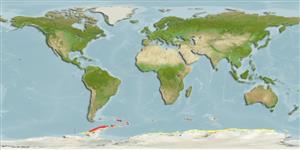>
Perciformes/Notothenioidei (Icefishes) >
Nototheniidae (Cod icefishes) > Nototheniinae
Etymology: Nototheniops: Greek, noton = filament + Greek, adverbial particle, then, that denotes distance or removal + Greek, opsis = appearance (Ref. 45335); larseni: Named for Captain C.A. Larsen, chief navigator of the Swedish Antarctic Expedition (Ref. 11892).
More on author: Lönnberg.
Environment: milieu / climate zone / depth range / distribution range
Écologie
marin benthopélagique; profondeur 30 - 750 m (Ref. 51730). Polar; 51°S - 70°S, 92°W - 166°E
Southern Ocean: Balleny Islands, Peter I Island, Palmer Archipelago, Graham Land, South Shetlands, South Orkneys, South Sandwich, South Georgia, Shag Rocks, Bouvet, and sub-Antarctic islands and seamounts of the Indian Ocean Sector (except Kerguelen, Heard, McDonald and Macquarie islands and Kara Dag seamount).
Length at first maturity / Taille / Poids / Âge
Maturity: Lm 22.5 range ? - ? cm
Max length : 24.0 cm TL mâle / non sexé; (Ref. 5179)
Épines dorsales (Total): 5 - 6; Rayons mous dorsaux (Total): 37-39; Rayons mous anaux: 37 - 38. Irregular oblique dark cross-bars on body. Distal part of spinous dorsal with black blotch, soft dorsal with oblique dark stripes. Anal plain or similarly marked. Breast to middle depth of pectoral fins a notable silvery-white (Ref. 11892).
Feeds mainly on krill, hyperiid amphipods and mysids. Spawning occurs in autumn and winter (Ref. 51730).
Dewitt, H.H., P.C. Heemstra and O. Gon, 1990. Nototheniidae. p. 279-331. In O. Gon and P.C. Heemstra (eds.) Fishes of the Southern Ocean. J.L.B. Smith Institute of Ichthyology, Grahamstown, South Africa. (Ref. 5179)
Statut dans la liste rouge de l'IUCN (Ref. 130435)
Menace pour l'homme
Harmless
Utilisations par l'homme
Plus d'informations
RéférencesAquacultureProfil d'aquacultureSouchesGénétiqueElectrophoresesHéritabilitéPathologiesTraitementNutrientsMass conversion
CollaborateursImagesStamps, Coins Misc.SonsCiguateraVitesseType de nageSurface branchialeOtolithesCerveauxVision
Outils
Articles particuliers
Télécharger en XML
Sources Internet
Estimates based on models
Preferred temperature (Ref.
123201): -1.4 - 1.9, mean 0 °C (based on 115 cells).
Phylogenetic diversity index (Ref.
82804): PD
50 = 0.6250 [Uniqueness, from 0.5 = low to 2.0 = high].
Bayesian length-weight: a=0.00490 (0.00401 - 0.00598), b=3.22 (3.16 - 3.28), in cm total length, based on LWR estimates for this species (Ref.
93245).
Niveau trophique (Ref.
69278): 3.3 ±0.3 se; based on diet studies.
Generation time: 4.1 ( na - na) years. Estimated as median ln(3)/K based on 2
growth studies.
Résilience (Ref.
120179): Milieu, temps minimum de doublement de population : 1,4 à 4,4 années (K=0.27; Fec = 2,046).
Fishing Vulnerability (Ref.
59153): Low to moderate vulnerability (32 of 100).
Climate Vulnerability (Ref.
125649): Low to moderate vulnerability (32 of 100).
Nutrients (Ref.
124155): Calcium = 26.6 [16.3, 63.4] mg/100g; Iron = 0.454 [0.188, 0.884] mg/100g; Protein = 16.4 [15.1, 17.6] %; Omega3 = 0.414 [0.202, 0.819] g/100g; Selenium = 16.5 [6.5, 35.9] μg/100g; VitaminA = 33 [8, 144] μg/100g; Zinc = 0.532 [0.360, 0.790] mg/100g (wet weight);
